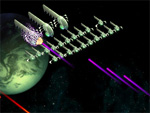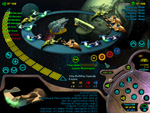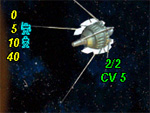The Geryk Analysis
|
 |
 |
 |
About one million years later in computer game time, SSG released a sequel to Reach for the Stars, called Reach for the Stars. There are lots of laws that are only known to people like me who think about computer games far too much. One of these laws is that games from the olden days cannot be as good now as they were back then. There are a lot of complicated reasons for this, one of which is that asterisks are far less representative of stars now than they were when Carl Sagan was alive. At that time, the asterisk was the best possible way you could portray a star system on a computer (narrowly edging out the not-quite-as-starlike letter “X”). Appropriate ways for denoting advances in technology involved Roman numerals, since back then it wasn’t so long ago that we were in Roman times. Thus, the tech known as Missile I was followed by Missile II. There were probably only three Missile techs, total, because by the time you counted the asterisks, the techs, and the screen with the credits on it, you had pretty much filled up your 16K of memory. Needless to say, a backstory was an unimaginable luxury that probably got printed as an afterthought in an issue of Vanity Fair, to which you could subscribe if you called the number on the screen when you beat the game on the hardest level. Since you had to finish the game to find this out, the backstory really didn’t have much to do with playing.
That all changed when computers got CD-ROM drives and full-motion video. All of a sudden, backstories became indispensable. Some even developed lives of their own and became full-fledged games, or even short novels and the resulting TV series. But behind all the inflated egos and contract disputes and writers’ strikes, these stories were serving an important purpose: they were allowing games to become more complex.
 |
 |
 |
Lots of gamers completely missed this point, choosing instead to take the stories at face value as art, and to favorably compare the story in one role-playing game about being dead to the one in another role-playing game about killing orcs. You know what? You or I or anyone reading this could walk to his bookshelf right now, pick up anything by Flannery O’Connor, and immediately have a story that is more than one billion times better than the best computer game story times one zillion other stories. So obviously the stories themselves aren’t what’s important – it’s what they do. Or what they don’t do, if – like the designers of Reach for the Stars – you forget to put one in that makes any sense.